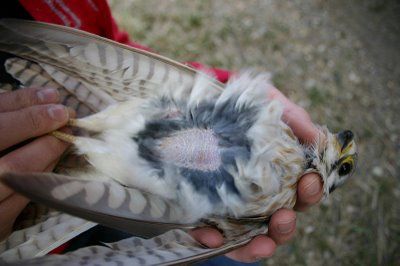
23 April 2010
Imagine trying to keep your children warm on a cold night by hugging them to the outside of your winter coat. They will still be cold unless you open your coat and hug them to your skin.
Birds incubate their eggs and brood their chicks by “opening their coats” to keep their children warm.
Feathers are great insulation so during the nesting season birds must develop a bare patch of skin — a brood patch — to allow the eggs to come in direct contact with their bellies. The brood patch also has extra blood vessels close to the skin to heat the eggs. At the end of the nesting season the blood vessels recede and the feathers grow back to keep the adult warm.
In species where only the female incubates, the male doesn’t develop a brood patch. In peregrines, Birds of the World explains that both male and female peregrine have brood patches: “Both sexes have paired lateral brood patches. Less well developed in male.” Peregrine couples share incubation.
If you watch the streaming webcams you’ll see the adult peregrines rock up-and-down and side-to-side as they settle on the nest. This rocking opens the feathers that have curled over the brood patch and puts their skin in contact with the eggs or chicks.
Shown here is a brood patch on a female American kestrel, North America’s smallest falcon. The person holding the bird reveals the brood patch and the downy black feathers surrounding it by blowing upward on the bird’s belly.
Imagine how cold a brooding falcon can get in an updraft!
(photo by Jared B. Clarke, author of Bird Banding in Saskatchewan from his May 6, 2009 blog, Eggs have been laid)
More interesting information. I thought all that wiggling was just for tucking everyone in & smoothing out the stones underneath her. How nature doth provide them. Faith.
We’ve all been wondering about the side-to-side motion, and this explains it beautifully. Thanks again, Kate.
boy oh boy! (bird oh bird) you are sooooooooooooo smart about all the bird facts kate. i really love to watch the cams and learn all the facts. am disabled and my computer really links me to the world. am addicted to all the bird cams(other animals also) thank you very much from the bottom of my bird heart! XOXOXO
Kate, what a great anatomy lesson. My granddaughter and I were watching Dorothy last night and I told her what an amazing day we all had. She was very concerned as to how those little guys could breathe under their Mom like that. Tonight I can show her that they don’t have a face full of Mom’s feathers. Have a wonderful weekend. Just think..soon it will be Miss Dori’s turn!
Fascinating!! Thanks again for the great info on this blog. And the pictures from yesterday are wonderful!!
Hi Kate,
I met you at Schenley last summer when we were watching for the chicks to fledge. We did not get to see them take their first flight that morning but it was still fun to watch them practicing on the ledge. And it was great to finally meet you!
Thanks for this interesting info about the brood patch. I have been following the bird anatomy lessons.
Will you be able to get snapshots this year of E2 getting acquainted with his new babies and dropping off food?
E2: I hope so. Yesterday was so busy at the nest that Dorothy stayed there most of the day.
Kate,
What is wrong with E2?? He is lying on the nest with wings outspread.
What is going on at the nest!! It doesn”t look good to me.
Jane
I am wondering the same thing. I can’t get the chat to load for some reason. Thought I would check here.
Don’t worry. The weather is really nice here and E2 is sunbathing.
See this FAQ: http://www.birdsoutsidemywindow.org/peregrine-faqs/question-why-is-this-bird-face-down-on-her-nest/
Birds pant to stay cool. I’m guessing that he? is just “sunning” (enjoying that natural source Vitamin D that they absorb through their wings) and is panting to stay cool. Though I’m not an expert.
Thanks, Kate – sorry I missed that. He needs to get back to work with 5 new mouths to feed!
Thank goodness.
Thank you. I’m glad all is well and they are enjoying this beautiful day.
Kate, thank you for all your information! When are the chicks old enough to controle there own body temperature so the parents don’t have to do it for them?
I have heard of a brooding patch but never saw one! This is a fantastic explanation to go along with a great picture! Thanks for the informative anatomy lessons.
Fascinating. Thanks so much for the anatomy lessons!
>When are the chicks old enough to control there own body temperature?
That will be in about 8 days after hatching. Even when they are a little older than that the mother bird will try to brood them if it’s very cold or wet. Her difficulty will be that they’ve grown so big she has to stand up to keep them under her.
Glad to learn something today, surprised!